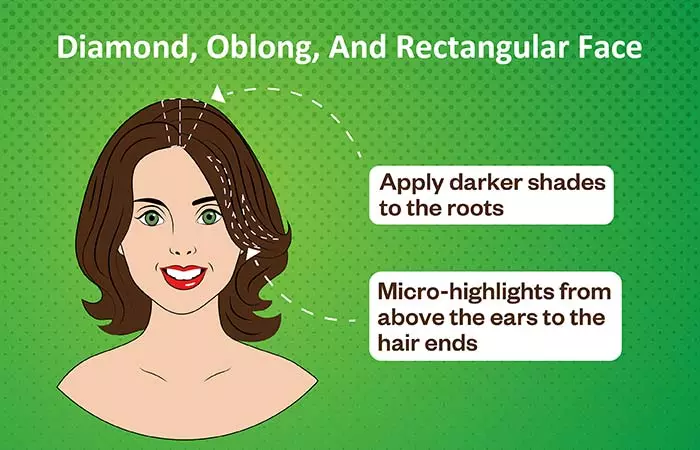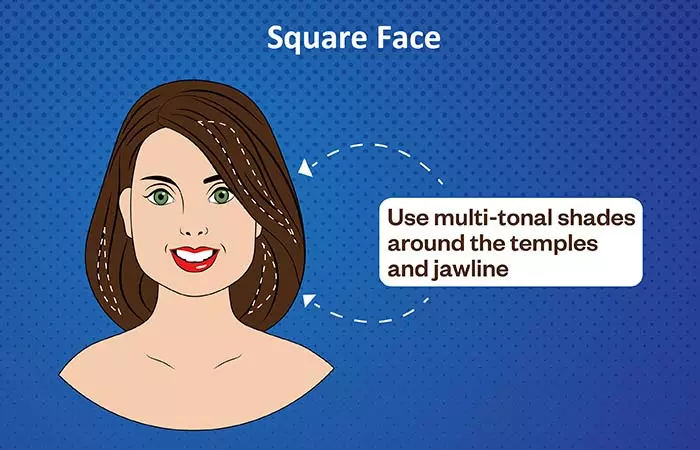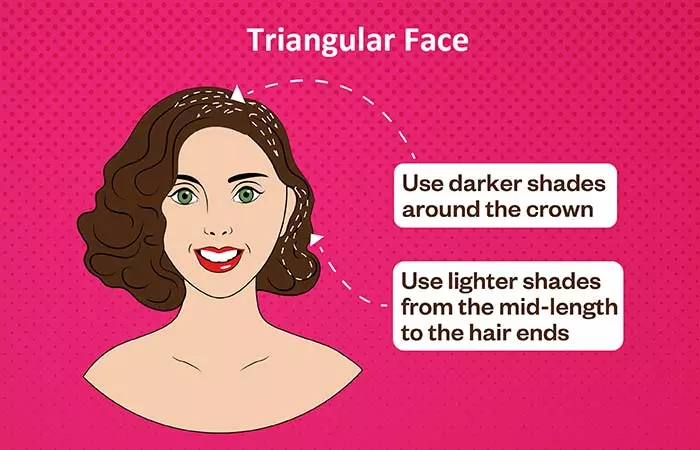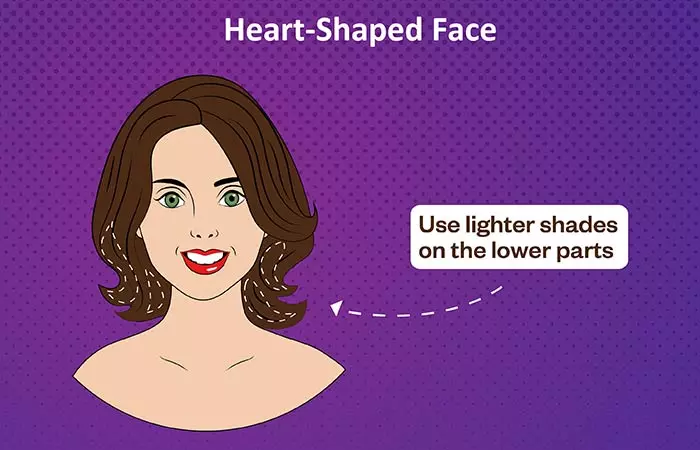What Is Hair Contouring?
Hair contouring or hair color contouring is a coloring technique that uses light and dark shades to highlight your facial features. It creates a soft, natural gradation and combines freehand and systematic dye application. In short, contouring your hair is like freehand painting the hair strands to highlight certain facial features and make your face appear oval and slim. It is more like creating a light and shadow effect to get the desired results. Learn more about it in the next section.
How Does Hair Contouring Work?
Hair color contouring involves a mixture of dark and light shades. The darker shades are positioned to make a broad face appear narrow or shorten a long face. Lighter shades highlight your hair and help broaden the narrow parts. This creates an illusion of distinct facial features. Depending on the features you want to highlight, your stylist will carefully apply the hair color by hand to add depth and density to your hair.
Is Hair Color Contouring Ideal For You?
Yes! Hair color contouring is suitable for all face shapes. It can highlight the unique features to flatter your face. However, you will have to experiment with different shades to see which ones emphasize your natural features. It is better to consult a professional hairstylist for guidance. The success of the hair contouring technique depends on the color, shades, and hairstyle, and how it frames your face. Keep reading to find out how you can enhance your facial features based on your face type.
How To Contour Hair According To Your Face Shape
1. Round Face
Round faces are symmetrical. They do not have prominent cheekbones. You can elongate the face slightly by applying lighter shades around the hairline, extending from ear to ear. Apply darker shades underneath your ears and along the lower ends of the hair to make your face appear longer. Michelle Crossan, a YouTuber, details her experience of hair contouring. She has a round face and explains that hair contouring is about adding lowlights and highlights to different areas of the face to suit the face shape. She said, “If you can see here underneath my hair, we have some darkness, and when that falls beside my jawline like this, it helps to slim down the roundness of my face, and as you can see, these light pieces around the front really just accentuate my eyes and bring so much lightness and brightness to my hair (i).”
2. Diamond, Oblong, And Rectangular Face
An oblong or rectangular face is longer than its width and may have a round chin and a broad forehead. Hair color contouring can slim down an oblong face. Angulate the face by adding darker shades along the roots to deepen the tone. Use micro-highlights around the face from above the ears until the hair ends.
3. Square Face
A square face has a broad forehead, cheekbones, and jawline. Use multi-tonal shades (light and dark colors) along the corner of your face, especially the temples and the jawline. This softens the wide facial features and adds depth.
4. Triangular Face
A triangle-shaped face has wide cheekbones and a narrow chin. Use lighter shades along the mid-length to the hair ends to soften the jawline and chin. Apply darker shades along the crown to add depth. Additionally, you can apply lighter shades in the hair sections along the hairline to highlight your face.
5. Heart-Shaped Face
A heart-shaped face is like an inverted triangle. Adding lighter shades along the jawline and ears can soften your chin and make your face appear oval. Leave the top of your hair darker to make your forehead appear narrow. Balayage is one hair contouring technique that adds a combination of light and dark hair colors to help highlight your best facial features. Find out more about it below.
Balayage For Hair Contouring
Balayage is a modern hair color contouring that involves expert stylists strategically placing lighter and darker tones to flatter and sculpt facial features, enhancing the hair’s natural movement. Unlike traditional highlights, balayage involves sweeping color onto selected strands without the use of foils, allowing for a more natural transition of shades. This method can bring out the eyes, accentuate cheekbones, and soften the jawline. The versatility of balayage makes it suitable for a broad range of hair types, lengths, and colors. So, if you are still stuck on the balayage vs. highlights debate for your next hair color session, try balayage for a smooth-melt highlight effect. It’s a low-maintenance option, making it ideal for clients seeking a subtle change that doesn’t require frequent salon visits. Before you opt for hair contouring, there are certain factors to keep in mind. Check out the next section to know more. These are a few contouring tricks you may use to highlight your facial features. However, consider the following factors before hair color contouring.
Things To Consider Before Contouring Your Hair
Ensure your highlights are not less than two shades lighter or darker than your natural hair color. This helps to give a natural appearance Get a suitable haircut that frames your facial features and then go for color contouring. Get both services from the same professional to get the best results. Check your forehead, cheekbones, and jawline to determine your face shape. Choose the color shades that complement your skin undertone. Talk to a professional to pick shades. Have your hair stylist perform a complete hair analysis to ensure the safety of the procedure. If you had previous color services, this is a must. But don’t be discouraged; talk to your hair care professional to build a treatment plan for before and after your service.
Does hair contouring look natural? Yes, hair contouring looks natural and gives you a youthful appearance. But be sure your hair stylist is a certified hair colorist, as not every hair stylist is trained in advanced techniques. Is hair contouring low maintenance? Yes, hair contouring is low maintenance compared to other techniques. However, you have to use products for color-treated hair to maintain the highlights. Watch the following video to master the art of contouring and highlighting through the blonding hair color technique. Check it out to learn how this method can add depth and dimension to your hair color.










